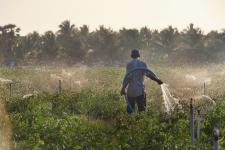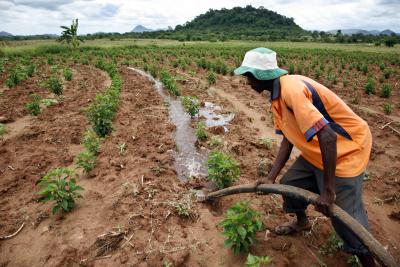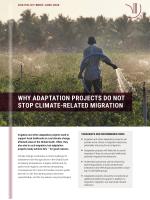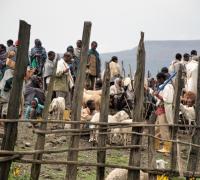Why adaptation projects do not stop climate-related migration

- Irrigation and other adaptation projects can provide more choice in migration decisions, potentially reducing forced migration.
- Adaptation projects will likely fail to curtail migration if they do not provide livelihoods potential migrants find attractive.
- Unintended outcomes can be reduced by anchoring projects in local contexts and institutions and reflecting local priorities, including of vulnerable groups.
- Adaptation projects should be considered an additional livelihood support in addition to migration; migration can also build climate resilience.
Climate change constitutes a critical challenge for subsistence rain-fed agriculture in the Global South. Increasing temperatures, irregular rainfall, and dry spells have negative, sometimes devastating, consequences for rural communities. Harvest yields diminish or fail, the planting season becomes unpredictable, and the dry season may be prolonged.
While subsistence farming has always been demanding in such areas, climate change amplifies these challenges. As a result, local communities draw on a range of alternative farming methods and livelihood strategies, ranging from employing different crops to seasonal or long-term migration.
Migration as an adaptation strategy, however, is widely rejected by international donors, national governments and sometimes local authorities. Rather, these actors often aim to enhance and promote local agriculture or other locally based livelihoods through in-situ adaptation projects, or adapting in place. This can be through providing (or selling) inputs to increase yields, e.g. drought resistant seeds, fertilizers or pest control; promoting new farming techniques, e.g. climate smart or conservation agriculture; or improving access to key resources, for instance water access through irrigation. Affected communities are supposed to stay where they are – in other words, deal with the challenges on the ground.
Perspectives from rural Ghana
This policy brief draws on findings from the collaborative Governing Climate Mobility research program (GCM). GCM examines climate change, migration and governance with a focus on Ghana where climate change is documented and migration and mobility are established livelihood practices, especially domestically and to neighbouring countries. It builds on a large survey and in-depth studies in the dry Savannah zone in the Upper West region and in the wetter forest zone in the Eastern Region of the country.
No matter how well implemented, adaptation projects will not be able to address the many, diverse reasons why people migrate.
GCM research shows that donor or government driven adaptation approaches are linked to perceptions of climate-related migration as an undesired outcome of climate change. Especially youth migration is widely seen as a problematic phenomenon that needs to be prevented or ‘managed’; indeed, some adaptation projects explicitly aim to curtail migration as a key objective. Local perceptions and practices of migration are thereby disregarded.
Mixed evidence from adaptation projects
A key finding of the GCM program is that the efficacy of adaptation interventions is mixed, particularly if curbing migration is a desired outcome. Certainly, adaptation projects may strengthen local livelihoods, enhancing farming or other livelihoods for those who want to stay. Distress migration may thereby be reduced for some groups. No matter how well implemented, however, such projects will not be able to address the many, diverse reasons why people migrate. Furthermore, they may have unintended outcomes which increase the occurrence or duration of migration.
Constructing small-scale dams, for instance, is thought to enable dry season farming through enabling irrigation of crops in periods without rain. The logic is that this will stop potential migrants from leaving as they can farm instead, putting an end to seasonal or long-term migration in the pursuit of work in other rural areas, plantations, mines, or urban centers.
This logic overlooks key functions of migration: it ignores that such mobilities are often well-established livelihood practices that diminish the number of mouths to feed and competition over local employment. It also disregards that migration constitutes an avenue to generate resources, such as food items, other goods and cash that may be used for food security, education, and investment in farming, trade or indeed in climate change adaptation purposes.
Climate change is an indirect driver of migration
To understand why local adaptation projects do not guarantee less migration from rural areas, we also need to factor in the overall role of mobility in society. In Ghana and West Africa more broadly, climate change enters into an already complex mobility context where migration is part and parcel of established livelihoods, is seen as a pathway to a better or more dignified life or, simply, as a way of expanding one’s horizon beyond one’s area of origin.
This also means that migration, and mobility more generally, are not typically caused by exceptional circumstances. Indeed, few people point to climate change as the main reason for moving when responding to surveys or in interviews. Instead, they refer to economic and livelihood motivations which climate change and variability generally affect negatively, especially in agrarian contexts. Climate change is therefore primarily an indirect driver of migration. Curtailing migration as a success criterion for adaptation interventions is therefore likely to fail.
The One Village – One Dam initiative
The One Village – One Dam scheme in Ghana is an example of a government initiative that aims to support local livelihoods as well as curb migration. Initiated in 2018, the goal is to provide all villages in the northern part of the country with an earth dam or dug-out site to establish irrigation and thereby promote all-year cropping. Crop production in these areas is otherwise interrupted by an annual dry season. The initiative also has the explicit aim of curtailing youth migration for alternative livelihoods during the dry season.
Local adaptation projects may provide additional livelihood options for households and individuals, which can support voluntary choice in staying or moving.
Our study shows that the outcomes of such dams have been mixed. For younger residents, one of the main target groups for the intervention, the dams have changed little. Their goals of improving their own or their families’ life conditions are generally not enabled by a local irrigation scheme in the context of widespread and persistent poverty and increasing climate variability. However, the projects have enabled some dry-season farming for those wanting to stay, particularly the older generation who generally are less prone to migrate.
Policy aims to reduce migration are also unrealistic due to limitations in project implementation that will be difficult to address. A large number of dams remain to be constructed, and problems of incomplete construction, lack of maintenance and institutional disputes have limited some dams’ provision of irrigation services. In one instance, an incomplete dam has contributed to flooding, rendering one village periodically inaccessible by land. As a result, the village’s access to the outside world, including the market, is largely cut off during the rainy season – leading some residents to migrate even earlier in the year rather than risk forced immobility.

Finally, even when these projects function as planned, irrigation schemes are not able to address other climate-related agricultural risks, including sudden downpours, pests and crop diseases that also damage crops, even entire harvests. Targeted adaptation interventions are therefore not a panacea solution to addressing the diverse climate risks that may factor into migration decisions.
Pitfalls and potentials
This policy brief outlines the tension between local adaptation interventions that aim to sustain livelihoods in rural climate change affected areas versus practices of migration out of these areas.
We show that local adaptation projects have both pitfalls and potentials: isolated projects will not be able to address the diverse drivers of migration, climate risks, and underlying causes of vulnerability, such as deep-seated poverty and inequality. However, they may provide additional livelihood options for households and individuals, which can support voluntary choice in staying or moving.
For migration decisions, more options at home allow potential migrants to better choose the type, timing and duration of potential migration, which will likely improve migration outcomes. Our findings indicate that, for best outcomes on the ground, staying or leaving should be a choice made by affected people rather than a policy objective.
DIIS Experts





